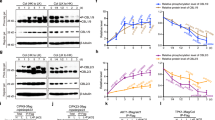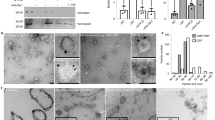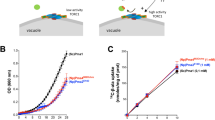Abstract
Magnesium (Mg2+) is an essential nutrient for all life forms. In fungal and plant cells, the majority of Mg2+ is stored in the vacuole but mechanisms for Mg2+ transport into the vacuolar store are not fully understood. Here we demonstrate that members of ancient conserved domain proteins (ACDPs) from Saccharomyces cerevisiae and Arabidopsis thaliana function in vacuolar Mg2+ sequestration that enables plant and yeast cells to cope with high levels of external Mg2+. We show that the yeast genome (as well as other fungal genomes) harbour a single ACDP homologue, referred to as MAM3, that functions specifically in vacuolar Mg2+ accumulation and is essential for tolerance to high Mg. In parallel, vacuolar ACDP homologues were identified from Arabidopsis and shown to complement the yeast mutant mam3Δ. An Arabidopsis mutant lacking one of the vacuolar ACDP homologues displayed hypersensitivity to high-Mg conditions and accumulated less Mg in the vacuole compared with the wild type. Taken together, our results suggest that conserved transporters mediate vacuolar Mg2+ sequestration in fungal and plant cells to maintain cellular Mg2+ homeostasis in response to fluctuating Mg2+ levels in the environment.
This is a preview of subscription content, access via your institution
Access options
Access Nature and 54 other Nature Portfolio journals
Get Nature+, our best-value online-access subscription
$29.99 / 30 days
cancel any time
Subscribe to this journal
Receive 12 digital issues and online access to articles
$119.00 per year
only $9.92 per issue
Buy this article
- Purchase on Springer Link
- Instant access to full article PDF
Prices may be subject to local taxes which are calculated during checkout






Similar content being viewed by others
Data availability
Data supporting the findings of this study are available within the paper and its Supplementary Information files. All Arabidopsis genes involved in this study can be found at TAIR (www.arabidopsis.org), with the following accession numbers: MGR1 (AT4G14240), MGR2 (AT4G14230), MGR3 (AT1G03270), MGR4 (AT1G47330), MGR5 (AT5G52790), MGR6 (AT4G33700), MGR7 (AT2G14520), MGR8 (AT3G13070) and MGR9 (AT1G55930). Yeast gene information is available at The Saccharomyces Genome Database (www.yeastgenome.org) as follows: MAM3 (YOL060C) and MNR2 (YKL064W). Other sequences can be found on the NCBI database (https://www.ncbi.nlm.nih.gov/), with accession numbers listed in Supplementary Table 2.
References
Karley, A. J., Leigh, R. A. & Sanders, D. Where do all the ions go? The cellular basis of differential ion accumulation in leaf cells. Trends Plant Sci. 5, 465–470 (2000).
Okorokov, L. A., Lichko, L. P. & Kulaev, I. S. Vacuoles: main compartments of potassium, magnesium, and phosphate ions in Saccharomyces carlsbergenis cells. J. Bacteriol. 144, 661–665 (1980).
Boller, T. & Wiemken, A. Dynamics of vacuolar compartmentation. Annu. Rev. Plant Phys. 37, 137–164 (1986).
Martinoia, E., Meyer, S., De Angeli, A. & Nagy, R. Vacuolar transporters in their physiological context. Annu. Rev. Plant Biol. 63, 183–213 (2012).
Martinoia, E. Vacuolar transporters – companions on a longtime journey. Plant Physiol. 176, 1384–1407 (2018).
Tang, R. J. & Luan, S. Rhythms of magnesium. Nat. Plants 6, 742–743 (2020).
Okorokov, L. A. et al. Free and bound magnesium in fungi and yeasts. Folia Microbiol. 20, 460–466 (1975).
Shaul, O. Magnesium transport and function in plants: the tip of the iceberg. Biometals 15, 309–323 (2002).
Hermans, C., Conn, S. J., Chen, J., Xiao, Q. & Verbruggen, N. An update on magnesium homeostasis mechanisms in plants. Metallomics 5, 1170–1183 (2013).
Walker, R. B., Walker, H. M. & Ashworth, P. R. Calcium-magnesium nutrition with special reference to serpentine soils. Plant Physiol. 30, 214–221 (1955).
Tang, R. J. et al. Tonoplast CBL-CIPK calcium signaling network regulates magnesium homeostasis in Arabidopsis. Proc. Natl Acad. Sci. USA 112, 3134–3139 (2015).
Amalou, Z., Gibrat, R., Trouslot, P. & D’Auzac, J. Solubilization and reconstitution of the Mg2+/2H+ antiporter of the lutoid tonoplast from Hevea brasiliensis latex. Plant Physiol. 106, 79–85 (1994).
Borrelly, G. et al. The yeast mutant vps5Delta affected in the recycling of Golgi membrane proteins displays an enhanced vacuolar Mg2+/H+ exchange activity. Proc. Natl Acad. Sci. USA 98, 9660–9665 (2001).
Shaul, O. et al. Cloning and characterization of a novel Mg(2+)/H(+) exchanger. EMBO J. 18, 3973–3980 (1999).
MacDiarmid, C. W. & Gardner, R. C. Overexpression of the Saccharomyces cerevisiae magnesium transport system confers resistance to aluminum ion. J. Biol. Chem. 273, 1727–1732 (1998).
Kolisek, M. et al. Mrs2p is an essential component of the major electrophoretic Mg2+ influx system in mitochondria. EMBO J. 22, 1235–1244 (2003).
Pisat, N. P., Pandey, A. & Macdiarmid, C. W. MNR2 regulates intracellular magnesium storage in Saccharomyces cerevisiae. Genetics 183, 873–884 (2009).
Li, L., Tutone, A. F., Drummond, R. S., Gardner, R. C. & Luan, S. A novel family of magnesium transport genes in Arabidopsis. Plant Cell 13, 2761–2775 (2001).
Schock, I. et al. A member of a novel Arabidopsis thaliana gene family of candidate Mg2+ ion transporters complements a yeast mitochondrial group II intron-splicing mutant. Plant J. 24, 489–501 (2000).
Tang, R. J. & Luan, S. Regulation of calcium and magnesium homeostasis in plants: from transporters to signaling network. Curr. Opin. Plant Biol. 39, 97–105 (2017).
Yan, Y. W. et al. Magnesium transporter MGT6 plays an essential role in maintaining magnesium homeostasis and regulating high magnesium tolerance in Arabidopsis. Front. Plant Sci. 9, 274 (2018).
Li, J. et al. Diel magnesium fluctuations in chloroplasts contribute to photosynthesis in rice. Nat. Plants 6, 848–859 (2020).
Conn, S. J. et al. Magnesium transporters, MGT2/MRS2-1 and MGT3/MRS2-5, are important for magnesium partitioning within Arabidopsis thaliana mesophyll vacuoles. New Phytol. 190, 583–594 (2011).
Wang, C. Y. et al. Molecular cloning and characterization of a novel gene family of four ancient conserved domain proteins (ACDP). Gene 306, 37–44 (2003).
de Baaij, J. H. et al. Membrane topology and intracellular processing of cyclin M2 (CNNM2). J. Biol. Chem. 287, 13644–13655 (2012).
Hirata, Y., Funato, Y., Takano, Y. & Miki, H. Mg2+-dependent interactions of ATP with the cystathionine-beta-synthase (CBS) domains of a magnesium transporter. J. Biol. Chem. 289, 14731–14739 (2014).
Stuiver, M. et al. CNNM2, encoding a basolateral protein required for renal Mg2+ handling, is mutated in dominant hypomagnesemia. Am. J. Hum. Genet. 88, 333–343 (2011).
Yamazaki, D. et al. Basolateral Mg2+ extrusion via CNNM4 mediates transcellular Mg2+ transport across epithelia: a mouse model. PLoS Genet. 9, e1003983 (2013).
Armitano, J., Redder, P., Guimaraes, V. A. & Linder, P. An essential factor for high Mg(2+) tolerance of Staphylococcus aureus. Front. Microbiol. 7, 1888 (2016).
Sinharoy, S. et al. A Medicago truncatula cystathionine-beta-synthase-like domain-containing protein is required for rhizobial infection and symbiotic nitrogen fixation. Plant Physiol. 170, 2204–2217 (2016).
Schaffers, O. J. M., Hoenderop, J. G. J., Bindels, R. J. M. & de Baaij, J. H. F. The rise and fall of novel renal magnesium transporters. Am. J. Physiol. Ren. Physiol. 314, F1027–F1033 (2018).
Funato, Y. & Miki, H. Molecular function and biological importance of CNNM family Mg2+ transporters. J. Biochem. 165, 219–225 (2019).
Yang, M., Jensen, L. T., Gardner, A. J. & Culotta, V. C. Manganese toxicity and Saccharomyces cerevisiae Mam3p, a member of the ACDP (ancient conserved domain protein) family. Biochem. J. 386, 479–487 (2005).
Schmidt, U. G. et al. Novel tonoplast transporters identified using a proteomic approach with vacuoles isolated from cauliflower buds. Plant Physiol. 145, 216–229 (2007).
Cunningham, K. W. & Fink, G. R. Calcineurin inhibits VCX1-dependent H+/Ca2+ exchange and induces Ca2+ ATPases in Saccharomyces cerevisiae. Mol. Cell. Biol. 16, 2226–2237 (1996).
Pittman, J. K. Vacuolar Ca(2+) uptake. Cell Calcium 50, 139–146 (2011).
Tang, R. J., Wang, C., Li, K. & Luan, S. The CBL-CIPK calcium signaling network: unified paradigm from 20 years of discoveries. Trends Plant Sci. 25, 604–617 (2020).
Gibson, M. M., Bagga, D. A., Miller, C. G. & Maguire, M. E. Magnesium transport in Salmonella typhimurium: the influence of new mutations conferring Co2+ resistance on the CorA Mg2+ transport system. Mol. Microbiol. 5, 2753–2762 (1991).
Eshaghi, S. et al. Crystal structure of a divalent metal ion transporter CorA at 2.9 angstrom resolution. Science 313, 354–357 (2006).
Lunin, V. V. et al. Crystal structure of the CorA Mg2+ transporter. Nature 440, 833–837 (2006).
Mumberg, D., Muller, R. & Funk, M. Yeast vectors for the controlled expression of heterologous proteins in different genetic backgrounds. Gene 156, 119–122 (1995).
Clough, S. J. & Bent, A. F. Floral dip: a simplified method for Agrobacterium-mediated transformation of Arabidopsis thaliana. Plant J. 16, 735–743 (1998).
Yoo, S. D., Cho, Y. H. & Sheen, J. Arabidopsis mesophyll protoplasts: a versatile cell system for transient gene expression analysis. Nat. Protoc. 2, 1565–1572 (2007).
Robert, S., Zouhar, J., Carter, C. & Raikhel, N. Isolation of intact vacuoles from Arabidopsis rosette leaf-derived protoplasts. Nat. Protoc. 2, 259–262 (2007).
Acknowledgements
We thank ABRC for provision of A. thaliana seed stocks, and C. W. MacDiarmid for gifting yeast strains DY1514 and mnr2Δ. This work was supported by the National Science Foundation (no. MCB-1714795 to S.L.), the Innovative Genomics Institute at the University of California-Berkeley and the National Natural Science Foundation of China (grant no.31770267 to W.-Z.L.). C.W. is partly sponsored by a Tang Distinguished Scholarship at the University of California-Berkeley.
Author information
Authors and Affiliations
Contributions
R.-J.T., S.-F.M., W.-Z.L. and S.L. conceived the study and designed the experiments. R.-J.T. performed all experiments on yeast. R.-J.T., S.-F.M. and X.-J.Z. performed most of the molecular cloning and genetic work in plants. R.-J.T. and B.Z. carried out ion measurements. Y.Y. and F.-G.Z. assisted with subcellular localization and gene expression analysis. C.W. helped with phylogenetic analysis and preparation of some of the figures. A.-G.F. coordinated the project. R.-J.T. and S.L. wrote the manuscript. All authors discussed the results and commented on the manuscript.
Corresponding authors
Ethics declarations
Competing interests
The authors declare no competing interests.
Peer review
Peer review information
Nature Plants thanks Jian Feng Ma, Enrico Martinoia and the other, anonymous, reviewer(s) for their contribution to the peer review of this work.
Additional information
Publisher’s note Springer Nature remains neutral with regard to jurisdictional claims in published maps and institutional affiliations.
Supplementary information
Rights and permissions
About this article
Cite this article
Tang, RJ., Meng, SF., Zheng, XJ. et al. Conserved mechanism for vacuolar magnesium sequestration in yeast and plant cells. Nat. Plants 8, 181–190 (2022). https://doi.org/10.1038/s41477-021-01087-6
Received:
Accepted:
Published:
Issue Date:
DOI: https://doi.org/10.1038/s41477-021-01087-6



